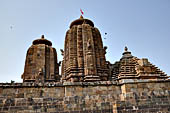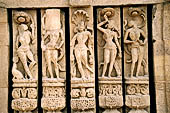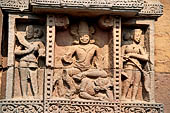On the outskirts of the town the Saivite Brahmesvara temple still houses a living deity, as indicated by the saffron pennant flying from the top of the tower. As soon as we entered the high enclosure walls of the temple complex we were approached by the Brahmin that offered to show us the temple. In the four corners of the walled courtyard there are four auxiliary shrines (pancayatana plan).
The deul and the jagmohana are in the mature Orissan style with a considerable resemblance with Lingaraja. The pyramidal roof of the jagamohan is capped with an inverted bell and kalasa on the top.
Brahmesvara Mandir |

|
Having passed the entrance of the enclosure wall it appears a small image of Lakshmi carved on the northern face of the deul covered in red cloth.
Filled by the smell of bat urin, we were not allowed to step inside the richly carved dark interior of the jagmohana.
The 18 m. tower is embellished with bho motifs and, on the lower section, with miniature temples, vyala rampant lions, dikpalas and other secular figures, including erotic couples.
On the southern wall of the jagmohana a severely damaged sculpture of Yama seated on his buffalo. The god wears a sacred cord, a necklace, earrings and high single pointed crown. On his left side a noose can be seen; on the right side the top of his staff. An other representation of Yama is found on the deul.

|
Brahmesvara Mandir
|
Both Saiva and Sakta deities have been depicted in their terrific forms. There are also deities like Ekapada (one legged) Shiva and, on the western facade of the deul, by the side of Nrrtti a Chamunda image, holding a trident and a human head (nri-munda), standing on a corpse with a jackal biting its head. Another figure of Chamunda is on the northern wall of the Jagamohana.
Brahmesvara Mandir |

|
Among the changes introduced by the Tantric iconographic program is the representation of dancers and musician, previously limited exclusively to Siva Nataraja. Female dancers with musical instruments appear for the first time on the balusters of the lattice-windows of the jagamohana, a type of decoration that will became a standard on most later Orissan temples.
On the northern side of the jagamohana, above the balusters an image of a dancing female, accompanied by musicians, holding a pidha roof with her uplifted left hand suggests us that dancing performances took place in the jagamohana. The commemorative inscription of the temple gives the evidence that the devadasi system was recognised as early as the eleventh century.
In addition numerous female deities, generally Tantric in nature, are represented in dance poses including Chamunda, and on the corner auxiliary shrines a dancing Ganesa.

|
Brahmesvara Mandir
|
In the Brahmesvara temple there are the earliest images of sikshadana motif showing a guru instructing his disciples, probably illustrating Tantric practices (in later temples the same motif has been transformed into the king surrounded by his court). The guru is represented seated in profile, larger in size than the surrounding figures, relaxed with one knee raised, his left hand on his right foot, his right hand is raised in a gesture of explanation. Beneath these motif there is a small image of either Ganesa or Saraswati, the gods of eloquence, wisdom and learning.
Brahmesvara Mandir |

|
|
|
|



